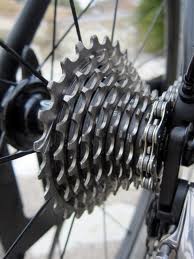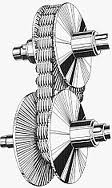2016 Subaru Outback Cvt 1st Gear Hard Shift
Subaru Lineartronic® Continuously Variable Transmission (CVT)
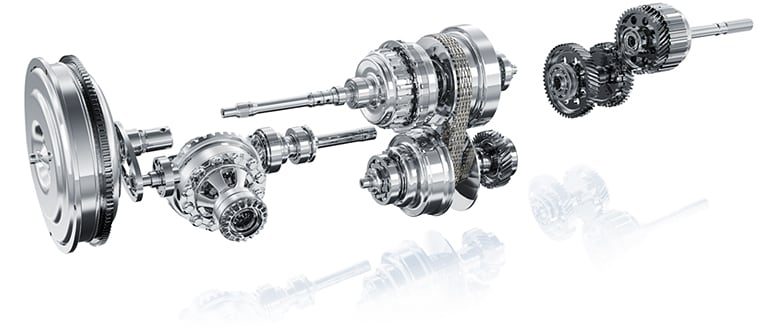
For instant, seamless response to changing atmospheric condition, the redesigned Lineartronic Continuously Variable Transmission elevates efficiency of the BOXER engine and Symmetrical AWD past keeping the engine in its ideal power range. Featuring a reinforced manual case and new torque converter, Lineatronic delivers a smoother ride while also reducing mechanical noise during operation. Adaptive control automatically shifts to the most optimal gear to arrange whatsoever driving style and road condition, while a stepped variable control is in melody with changes in engine speed, maximising drivability and performance.
Lineartronic is designed for linear response, and of course predictable driving means more fun backside the bike. Yet there is more than simply selecting the most appropriate gear ratio. Another advantage of CVT is that it allows the engine to operate longer at a lower speed than conventional automated transmission systems. A lower engine speed ways better fuel economy. And CVTs likewise evangelize a smoother ride, every bit it eliminates shocks when changing gears, and allows the engine to run quieter.
| Regular Transmission | Lineartronic CVT |
This is what your bicycle looks like: | Subaru's continuously variable |
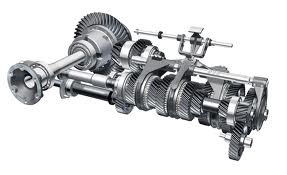 Regular transmission cutaway-- See the fixed gears? | 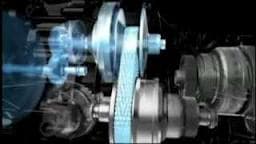 Lineartronic CVT cutaway-- just pulleys that vary their width. |
Showtime of all, how does a regular manual with gears piece of work?
Remember the ten-speed wheel you rode as a teen? On the back wheel, there were unlike size gears. A human can only pedal so fast, and with so much power, so to make the nigh of your endeavor you used different gears for dissimilar speeds. Uphill, when you lot needed all your power at a slow speed, you used the wide gear. Downhill, when you were already cruising fast, you needed the narrow gear to go fifty-fifty faster. Traditional transmissions in vehicles employ the same principle. The transmission shifts gears to provide the most appropriate ratio for a given situation: lowest gears for starting out, centre gears for acceleration and passing, and college gears for fuel-efficient cruising. Most vehicles with conventional gears accept four or five different speeds.
How does the CVT compare to a regular geared transmission?
The controls are the same inside the car: t wo pedals (no clutch) and a P-R-N-D-L-style shift pattern. But instead of gears, the CVT has ii pulleys that can vary in width, and a steel belt that connects them. By getting narrower or fatter, these pulleys change the relationship of engine speed to car speed. And because these pulleys tin vary their width infinitely, they are "continuously variable." When driving a auto with a CVT, you never hear or feel the manual shift -- it merely raises and lowers the engine speed as needed, calling up higher engine speeds (or RPM) for meliorate acceleration and lower RPM for better fuel economy while cruising.
What does a CVT feel similar when driving?
Many people don't notice the difference. Mod cars with regular transmissions shift then smoothly that yous don't really experience the gears changing. Y'all may observe a difference if you pay shut attention. With a CVT, in that location are no gears, period, so you hear the engine rev when you lot printing the accelerator but you never feel whatever power interruption equally the gears change. The engine finds its ability ring, and the transmission keeps the gear ratios married to that sweet spot for maximum power and fuel efficiency.
What does information technology do for me?
- Power. Engines do non develop constant power at all speeds; they have specific speeds where torque (pulling power) and horsepower (speed power) are at their highest levels. The CVT finds that exact spot and stays right in that location.
- Fuel economic system. For example, for the 2014 Forester, Subaru introduced a CVT. With the same engine as the previous generation, the new Forester gets FIVE (!) more mile per gallon. The CVT finds the most fuel efficient point in the engine ability band and keeps information technology in that location. The fuel economy is then impressive with a CVT that information technology beats the manual transmission!
- Less w eight. Without that heavy gearset and all those actress parts, a CVT has less mass, which helps fuel economy, handling, and acceleration.
- Dispatch speed. A regular transmission tin't go along to apply power while the transmission is shifting because information technology would damage it. The CVT is designed to send power to the wheels without any interruption.
- Smoother accel eration. A regular transmission tin can feel jerky, especially under full throttle. The CVT builds power in a smooth, linear manner, hence the trademark, "Lineartronic."
- G reater reliability. The CVT has fewer parts to interruption.
- Manual mode when y'all need it . If y'all're towing, or yous just want the thrill of changing gears, Subaru gives you lot paddle shifters mounted correct behind the steering cycle and so you lot can choose from half-dozen preset "gears" (which are not actually gears simply merely programmed set points along the continuum). Excludes Forester.
DOWNLOAD HERE
2016 Subaru Outback Cvt 1st Gear Hard Shift UPDATED
Posted by: melvinstlited39.blogspot.com
